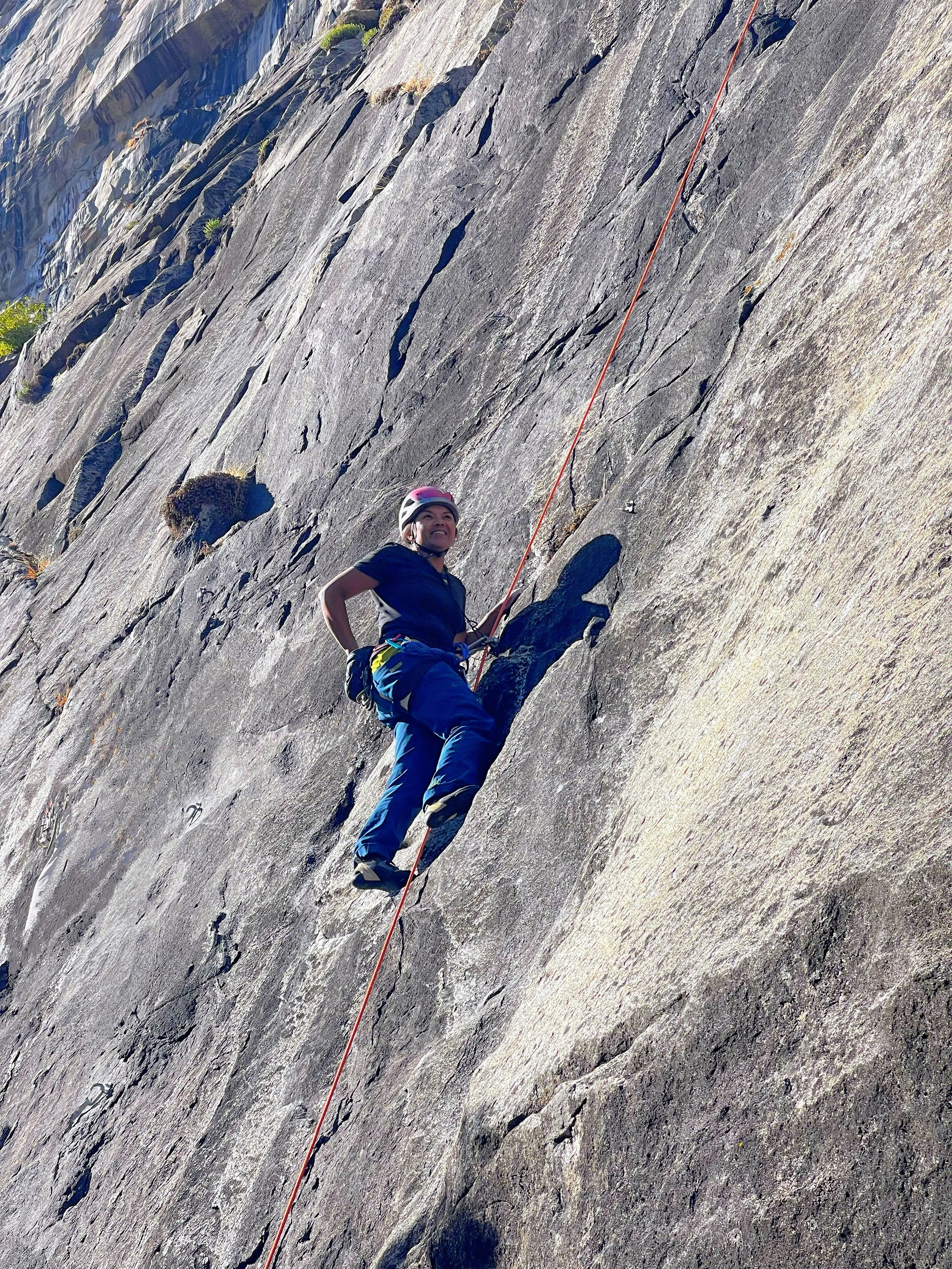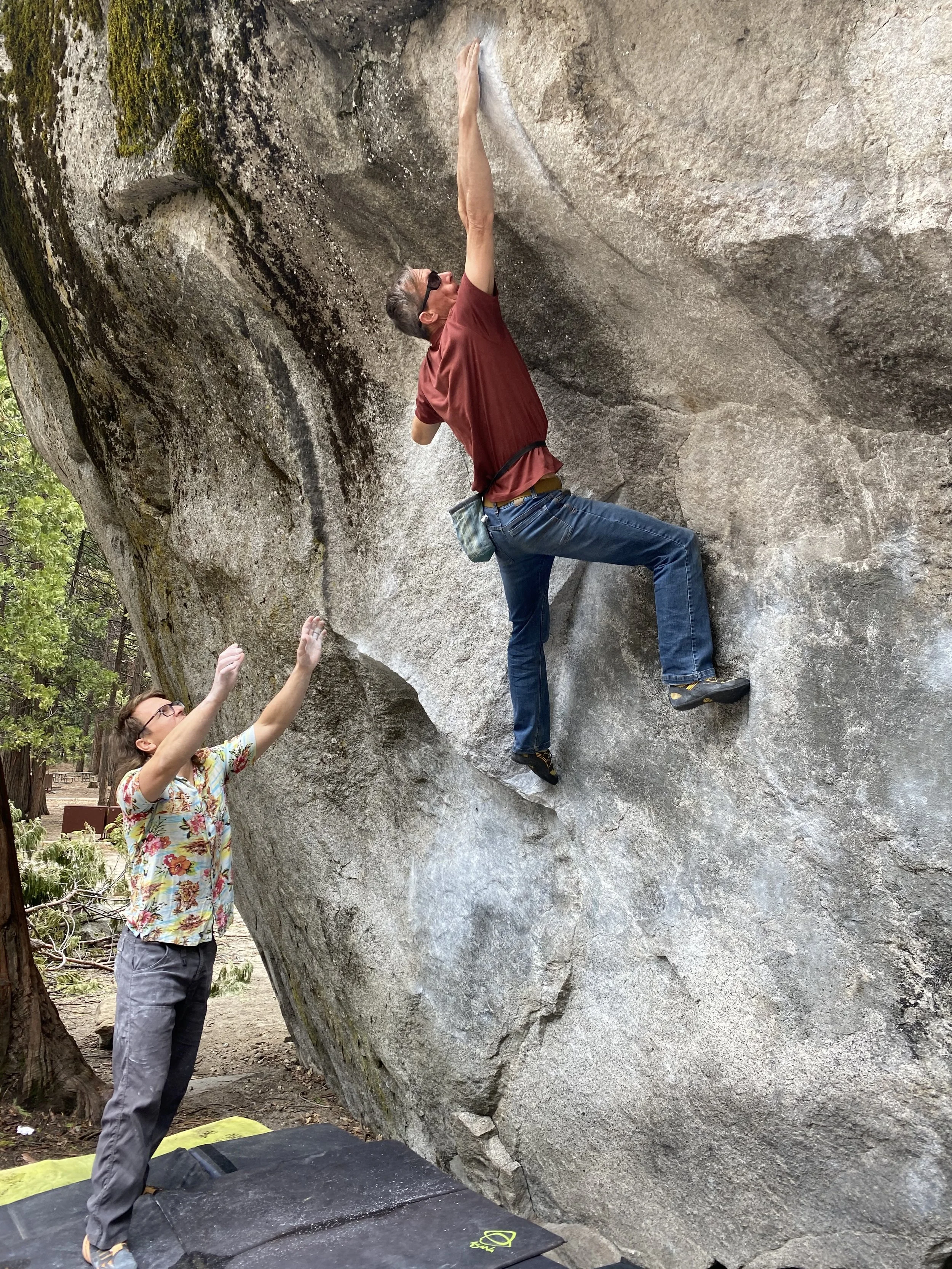EDITION 30 - OCTOBER 27, 2025
Your window into the stories, history, and ongoing work to preserve Yosemite’s climbing legacy.
A Note from the Editor
“Happy to share — I freed Triple Direct (which I believe is the first free ascent) over 3 days, then a few days later freed the Nose in 9.5 hours, no falls!” That’s the text Connor Herson sent over to me on Tuesday, October 21.
Mountain Project describes the El Cap route, put up by Jim Bridwell and Kim Schmitz in 1969, as “3,200 ft (970 m), 30 pitches, Grade VI.” Mountain Project states:
Pitches 1–10: Take the Freeblast to Mammoth Terrace
Pitches 11–14: Climb these Muir pitches to Grey Ledges
Pitches 15–16: Two more Muir pitches right up before the Shield Roof
Pitches 17–19: Traversing pitches to end up at Camp IV on The Nose
Pitches 20+: Take The Nose up to the top!
The route was once known as the “Integral Route.”
Herson continues, “Changing Corners is still the crux. For free climbing, it’s effectively the Nose with a harder start. Before the Great Roof, the hardest pitch on the Nose is 12a, but Triple Direct has a few 5.12 and 5.13 pitches shared with the Muir Wall.”
He adds, “I first freed the Nose in 2018, then in 2019 tried to free Triple Direct with my dad. It was satisfying to finish it off this year! Both ascents this year (NIAD and 3D) were with my dad supporting.”
In other El Cap news, Oliver Tippet wrote on Instagram:
Over the last month in Yosemite, I’ve been working on establishing a new route on El Cap. I spent 20 days working on it — six fixing up to and off Heart Ledge, and then 14 days on the wall on my final push.
I climbed about 1,000 ft of entirely new terrain, and another 1,000 ft of terrain that had been climbed but was undocumented and not part of any route that I know of (please let me know if you know what any of it is).
Most of the ground that had been climbed and documented that I went up was part of Verano Mágico, an obscurity with no real topo and no second ascent in 40 years.
It felt incredibly adventurous to climb El Cap with no topo and no information on 90% of the terrain — an experience I’d love to do again once I forget about how miserable hand-drilling 10mm bolts in granite is.
Cardiac Arrest — VI 5.8 A3 (Modern).
In his next post, he wrote:
Modern A3 to me means potential for 30 ft falls but nothing to hit, which I believe fits what I did. It says nothing about how thin some of the climbing is between the good gear.
I’d say my route is of a similar technical difficulty to Tempest, which you should do before even considering mine since it’s the best route on El Cap imo.
I just got off the phone with Jacob Hawley, Operations Manager of the Mariposa Visitor Center and Executive Director of the Mariposa Chamber of Commerce, who reported strong local business growth in Mariposa following the government shutdown.
“As of October, we are up 20 percent in tourism, and retail shops are up 85 percent in sales,” says Hawley. “All downtown businesses have seen a big influx in visitation and revenues, as well as hotels. We’re seeing July-level visitation numbers in October—everybody is doing extremely well.”
As for Yosemite Valley, he added, “The waterfalls are on right now—that’s a huge deal. It’s one of the earliest years we’ve had waterfalls come about.”
Regarding park visitation, the Yosemite Conservancy posted:
What is open in Yosemite right now?
In addition to all portions of the park that are normally open to the public 24/7, these locations and services are available:
Park entrances (gates are not staffed), roads, trails, Yosemite Valley, backcountry, and wilderness areas
Campgrounds (subject to normal seasonal closures)
Yosemite Conservancy bookstores at the Welcome Center and The Depot at Mariposa Grove (open 9 a.m.–5 p.m. daily)
Happy Isles Art & Nature Center
Yosemite Conservancy programs, including Outdoor Adventures, art classes, and volunteer programs
Yosemite Hospitality lodging, hotels, retail stores, and restaurants
Lodging and services outside the park are unaffected and remain open
What is closed or reduced?
NPS-run visitor centers will be closed and ranger programs paused
(Yosemite Conservancy-run art and adventure programs are running as scheduled)
This week in Mariposa, I hosted Forest Stearns and Erik Lucero (see the previous newsletter for their feature story) from Google Quantum AI in Santa Barbara. We e-biked in the sunshine, mountain biked in the rain, and today (Friday, Oct. 24) they’re in Yosemite Valley making art. Learn more about their collaborations here.
While riding in a downpour the other day, texts came in from Sasha DiGiulian, who said she’s back in Yosemite and working on her latest El Cap free-climbing project.
This week, we’re profiling longtime Yosemite climber Mecia Serafino, who is the Director of Outreach and Digital Content for Friends of YOSAR (Yosemite Search and Rescue). Wrote the board of FOYOSAR in the latest newsletter:
Yosemite Search and Rescue is one of the busiest wilderness SAR services in the country and averages in excess of one hundred rescue missions every year. As we continue through the busy season and beyond, we hope for as few incidents as possible, yet are prepared to provide aid to lost and injured visitors who come to enjoy the grandeur of Yosemite.
Chris Van Leuven
Editor, Yosemite Climbing Association News Brief
YosemiteClimbing.org
Join YCA’s Mecia Serafino at Hyperion Redwood City for the BATTLE OF THE BAY BOULDERING COMPETITION!
Attend the largest bouldering competition (and celebration!) in the country: Touchstone’s Battle of the Bay 2025 on Saturday, November 1st.
Taking place at Hyperion Climbing, this year’s Battle of the Bay includes two climbing categories:
Citizens Category
Our all-level competition includes a newly set gym with unique comp-style problems. After climbing hard, party harder with free food, beer, and prizes.
Open Category
Our heavy-hitter competition offers a chance at the crown and a $15,000 cash purse!
Mecia Serafino will be onsite representing YCA and Friends of YOSAR, be sure to say hello!
Mecia putting on a climbing clinic. Photo: Katelyn McDonald
Bridging the Gap: Mecia Serafino’s Mission to Guide Gym Climbers Outdoors
As Director of Outreach for Friends of YOSAR, Serafino helps new climbers make the transition from plastic holds to granite walls—emphasizing communication, mentorship, and safety
“I’ve been coming to Yosemite for about 17 years,” Serafino tells me over the phone from San Francisco. “My first visit to Yosemite was when I met you—we went to the base of El Cap and you guys were doing a couple pitches. I definitely fell in love with it. I’ve always liked nature animals, trees, and plants—it appealed to all my senses.”
When she said “you guys,” she meant me and her husband, Lucho Rivera, a longtime Yosemite climber whose decades of experience and first ascents span the Valley, Hetch Hetchy, Tuolumne Meadows, the Northern California coast, and Malaysia. Over the years, I’ve met up with Mecia and Lucho both in the park and at Bay Area crags, as well as at the Yosemite Facelift.
When Mecia and I chatted last week, she didn’t emphasize how hard she could climb—in fact, that never came up. Instead, she described her favorite style as “5-Fun”: moderate routes that offer big exposure and grandeur without the need to bear down on tiny crimps or jam technical cracks.
“I’m more or less hiking a lot and doing really easy climbs,” she says. She mentioned visiting Pat and Jack Pinnacle in Yosemite’s Lower Merced Canyon, where she and friends — people she’s mentoring — spent the day lapping the cruiser routes defined by massive xenolith knobs, features so large you can wrap your arm around them. The terrain, with its positive holds, high friction, and convenient single-rope descents, was perfect for introducing less experienced climbers to Yosemite’s stone.
She also talked about running up Great White Book, a five-pitch 5.6 classic on Stately Pleasure Dome in Tuolumne Meadows. Though she’d done the route many years ago as two parties of two, this time she shared it with her new friend Camilla Satte. “When we got to the top, instead of climbing left like I had before, we went right because it looked easier. We made it to the top, then walked down to the rappel. It’s something that’s been ingrained into my training that walking off is safer than rappelling.”
During that trip, Mecia also explored around Saddlebag Lake and scouted climbs below North Peak. “That’s the kind of stuff I’m stoked on—easy things/scrambling. Climbing outside is a form of meditation—being up there away from people, focused.”
In recent years, Mecia has also been frequenting Hetch Hetchy, revisiting sport climbs developed by Lucho, and former YOSAR members Jay Gustafson and Noah Dailey.
NPS describes the area as “Hidden in Yosemite National Park’s peaceful northwest corner, Hetch Hetchy Valley is a treasure worth visiting in all seasons. In spring, two of North America’s tallest waterfalls plummet spectacularly over thousand-foot granite cliffs. With its towering falls and dramatic domes, many have compared Hetch Hetchy’s grandeur to the more well-known Yosemite Valley.”
As for her current projects, Mecia says, “These days I’m doing a bit of everything. I still coordinate with the climbing rangers on their Gym-to-Crag events, and I do the site and social media for Friends of YOSAR. I’m still on the board for Restore Hetch Hetchy.”
Gym to Crag, hosted by the Bay Area Climbers Coalition, YCA (Yosemite Climbing Association), FOYOSAR, and YNP (Yosemite National Park) climbing rangers, is a series that teaches climbers how to transition safely and responsibly from the gym to the outdoors. Friends of YOSAR is a non-profit that supports Yosemite Search and Rescue with funding, training, equipment, and education beyond what federal budgets provide.
One of her main focuses has been reviving United in Yosemite, a climbing and community event organized initially by the American Alpine Club and Yosemite Conservancy, and formerly in partnership with Yosemite National Park. The event aims to elevate the voices of climbers and educators from historically marginalized backgrounds. “We’re hoping to get it going again next year,” she says. “We even took the planning committee out to Hetch Hetchy for some sport climbing.”
However, due to changes in federal funding, Diversity, Equity, and Inclusion (DEI) initiatives—like United in Yosemite—have faced budget cuts. Despite that, Mecia continues her stewardship and educational work. “I’ve been doing a lot of preventative search-and-rescue info for FOYOSAR,” she says. “It started with a collaboration with Lake Tahoe Community College to co-post educational content.”
The Gym-to-Crag clinics are tailored to participants’ experience levels
“We’ve taught the figure-eight, clove hitch, and how to set up a pre-rigged rappel with a third hand so people stay in the system,” she says. “We focus on communication—knowing the plan before you leave the ground. Are you lowering, cleaning, or rapping? Agree on language and backups. There’s a false sense of security from gyms, then folks go outside and realize, ‘Oh, this isn’t like climbing in the gym at all.’”
She adds, “There’s a lack of mentorship—people learn on YouTube, then guinea-pig outside. That’s how accidents happen.”
Mecia is now preparing to earn her AMGA Single Pitch Instructor (SPI) certification. “I’ve taken the course—I just need to test,” she says. The American Mountain Guides Association describes the SPI course as a 27-hour, three-day training designed for instructors who teach rock climbing on single-pitch terrain.
Regarding the test, Devil’s Lake Climbing Guides says, “Passing the American Mountain Guides Association (AMGA) Single Pitch Instructor (SPI) assessment earns you industry-standard certification for rock climbing.”
“It’s good information,” Mecia says. “There are newer methods I didn’t know—a lot of us in Yosemite back in the day just learned safety methods somehow.”
PHOTO OF
THE WEEK
Tom Herbert sending Midnight Lightning. Photo: Chris Van Leuven
Start planning your 2025 Yosemite climbing trip!
Learn everything you need to know about climbing in the park - from permit information to safety videos and tips from the Yosemite Conservancy!
Stay up to date on the latest climbing closures in effect!
Get your permits, do your research, and hit the wall!
Visit the Yosemite Climbing Museum!
The Yosemite Climbing Museum chronicles the evolution of modern day rock climbing from 1869 to the present.







